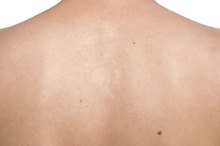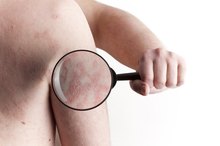What does fact checked mean?
At Healthfully, we strive to deliver objective content that is accurate and up-to-date. Our team periodically reviews articles in order to ensure content quality. The sources cited below consist of evidence from peer-reviewed journals, prominent medical organizations, academic associations, and government data.
- The World Allergy Organization Journal: Dermatology for the Allergist
- The World Allergy Organization Journal: Dermatology for the Allergist
- Centers for Disease Control and Prevention: Scabies -- Prevention & Control
The information contained on this site is for informational purposes only, and should not be used as a substitute for the advice of a professional health care provider. Please check with the appropriate physician regarding health questions and concerns. Although we strive to deliver accurate and up-to-date information, no guarantee to that effect is made.
Itchy Skin Between the Toes
You can’t feel comfortable when you have itchy feet. Whereas the skin on the soles of your feet is tough and hardened, the skin between your toes of soft and supple – and prone to infection if not cared for properly. Dry, itchy skin between your toes is often a sign of a fungal infection. The infection can often be cleared using over-the-counter medications. If left untreated, the infection may spread to your toenails or other areas of your body, requiring more extensive treatment.
Description
The appearance of the skin between your toes may give clues as to the cause of the itching and redness. Red, dry skin that sloughs off may be a sign of a fungal infection such as athlete’s foot or ringworm. If you see a red rash with bumps, it may be a sign of scabies, which is caused by mites burrowing beneath the skin. See your doctor for an accurate diagnosis and proper treatment of itchy skin between your toes.
- The appearance of the skin between your toes may give clues as to the cause of the itching and redness.
Causes
Dry Cracked Skin Around the Toes
Learn More
Feet and toes provide an ideal environment for fungi 3. The area between the toes is warm and often damp, and dead skin cells contain keratin as a food source for the fungi. Tinea pedis, also called athlete’s foot or ringworm, is the most common fungal infection between the toes. Scabies, or dermatophytes, may also cause a dry, itchy rash between the toes. Scabies are caused by mites burrowing beneath the skin.
- Feet and toes provide an ideal environment for fungi 3.
- The area between the toes is warm and often damp, and dead skin cells contain keratin as a food source for the fungi.
Transmission
Tinea pedis thrives in warm, damp areas, such as locker room floors and pool areas. The fungus spreads from person to person through direct contact with the rash and indirectly, for example, sharing towels or walking barefoot in public shower or locker room areas. Scabies are common in areas where people are in close contact, such as dorms, day care facilities or classrooms. The mites may also transfer to another person on clothing, sheets or towels.
- Tinea pedis thrives in warm, damp areas, such as locker room floors and pool areas.
- Scabies are common in areas where people are in close contact, such as dorms, day care facilities or classrooms.
Treatment
Bumps in a Circle on the Skin
Learn More
Most fungal infections clear with over-the-counter creams or lotions. Fungal infections between the toes may cause the skin to crack, which can allow bacteria to enter the body and cause a secondary infection. Bacterial infections must be treated with antibiotic cream or oral medications. If left untreated, fungal infections easily spread to other toes and toenails. Widespread infection requires treatment with oral antifungal agents, such as griseofulvin. Scabies respond to prescription creams, but the itching may continue for several weeks after treatment begins.
- Most fungal infections clear with over-the-counter creams or lotions.
- Scabies respond to prescription creams, but the itching may continue for several weeks after treatment begins.
Prevention
Prevent fungal infections by drying your feet thoroughly after bathing and before dressing. Change socks once daily and wear socks made from a breathable fabric, such as cotton or wool. The best way to prevent scabies is to avoid direct contact with an infected person's skin. Avoid using brushes, towels or bedding used by the infected person as well.
- Prevent fungal infections by drying your feet thoroughly after bathing and before dressing.
- Change socks once daily and wear socks made from a breathable fabric, such as cotton or wool.
Related Articles
References
- American Family Physician: Pediculosis and Scabies -- A Treatment Update
- The World Allergy Organization Journal: Dermatology for the Allergist
- Centers for Disease Control and Prevention: Scabies -- Prevention & Control
- Micali G, Lacarrubba F, Verzì AE, Chosidow O, Schwartz RA. Scabies: Advances in Noninvasive Diagnosis. PLoS Negl Trop Dis. 2016;10(6):e0004691. doi:10.1371/journal.pntd.0004691
- Chandler DJ, Fuller LC. A Review of Scabies: An Infestation More than Skin Deep. Dermatology (Basel). 2019;235(2):79-90. doi:10.1159/000495290
- Su WJ, Fang S, Chen AJ, Shan K. A case of crusted scabies combined with bullous scabies. Exp Ther Med. 2015;10(4):1533-1535. doi:10.3892/etm.2015.2668
- Crusted scabies. Genetic and Rare Diseases Information Center. Published June 17, 2019.
- Mccarthy JS, Kemp DJ, Walton SF, Currie BJ. Scabies: more than just an irritation. Postgrad Med J. 2004;80(945):382-7. doi:10.1136/pgmj.2003.014563
- Centers for Disease Control and Prevention (CDC). "Scabies—Resource for Health Professionals." Atlanta, Georgia; updated March 21, 2017.
- Stiff KM, Cohen PR. Scabies Surrepticius: Scabies Masquerading as Pityriasis Rosea. Cureus. 2017 Dec 19;9(12):e1961. doi: 10.7759/cureus.1961.








